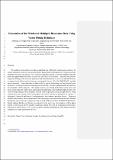Generation of the windowed multipole resonance data using Vector Fitting technique
Author(s)
Liu, Shichang; Peng, Xingjie; Josey, Colin; Liang, Jingang; Forget, Benoit Robert Yves; Smith, Kord S.; Wang, Kan; ... Show more Show less
DownloadAccepted version (2.134Mb)
Terms of use
Metadata
Show full item recordAbstract
The multipole representation provides an analytical way of Doppler broadening cross sections for neutron interactions and relies on a partial fraction decomposition that represents R-matrix resonance parameters by poles and residues. The windowed multipole method selectively broadens impactful poles and approximates the rest to increase the efficiency of the process. However, this process requires knowledge of the resonance parameters and certain limitations occur when additional channels are opened in the defined resolved resonance region such that only 2/3 of the ENDF/B-VII.1 nuclides can be processed. Some important nuclides needed in reactor applications such as Oxygen-16 and Hydrogen-1 are directly represented in point-wise form in the evaluation nuclear data library hindering the practicality of this approach. This paper presents a new fitting method for nuclear point-wise cross sections data that yields a pole and residue form analogous to the multipole representation. The Vector Fitting technique which originates from the field of signal processing was applied to the fitting of point-wise cross sections. Poles and residues from Vector Fitting were generated for Oxygen-16, Hydrogen-1, Boron-10 and Boron-11 and processed in the windowed multipole format. These new libraries were tested by direct comparison of the microscopic cross sections before and after Doppler Broadening, and by integral comparisons using a typical PWR pin cell from the BEAVRS benchmark. Results indicate that the new libraries are equivalent to the point-wise representation with the added benefit of allowing on-the-fly Doppler broadening without the need for temperature interpolation. Runtimes are approximately ∼28% slower using the multipole representation on this example problem compared to a single temperature ACE file. Keywords: Monte Carlo; Multipole; Doppler broadening; Vector Fitting; OpenMC.
Date issued
2017-10Department
Massachusetts Institute of Technology. Department of Nuclear Science and EngineeringJournal
Annals of Nuclear Energy
Publisher
Elsevier BV
Citation
Liu, Shichang et al. "Generation of the windowed multipole resonance data using Vector Fitting technique." Annals of Nuclear Energy 112 (February 2018): 30-41. © 2017 Elsevier Ltd
Version: Author's final manuscript
ISSN
0306-4549